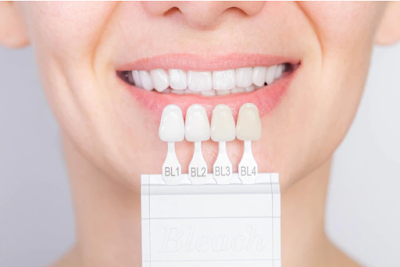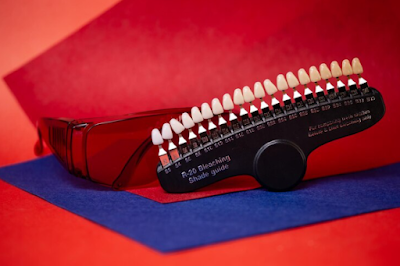Porcelain veneers are one of the most popular cosmetic dental procedures. And it’s no wonder why – they can completely transform your smile! If you’re considering getting veneers, this is the article for you. We’ll cover everything from what veneers are and how they work, to whether or not they’re right for you.
What are veneers?
If you're considering getting veneers, you probably have a
lot of questions. What are veneers? How do they work? What are the benefits?
We've got the answers to all of your questions about this popular cosmetic
procedure.
In order to enhance the appearance of teeth, thin,
tooth-colored shells known as dental veneers are bonded to the front surface of
the teeth. They are permanently attached to your teeth and frequently
constructed from porcelain or resin composite materials.
A variety of cosmetic issues, such as chipped, cracked,
discolored, or smaller-than-average teeth, can be treated with veneers.
When a tooth is cracked or chipped, some people may only
need one veneer, but many people need six to eight veneers to get a uniform,
symmetrical smile. The top eight front teeth receive veneers the most
frequently. Find more related content here Braces VS Invisalign Aligners Which One Is Best Orthodontic Treatment?
Different types of veneers
There are two main types of veneers: direct and indirect.
Direct veneers are made from a composite resin material and are applied
directly to the teeth. Indirect veneers are made from porcelain or ceramic and
are custom-made to fit over the teeth. However, "no-prep" veneers are
also available and use a different application method.
When placing traditional dental veneers, the tooth structure
must normally be ground down, occasionally even past the enamel. This enables
accurate installation but is also a painful, irreversible procedure that
frequently necessitates a topical anesthetic.
The number of teeth implicated and your dental misconceptions
will determine how many teeth need to be reduced. A dentist may request a wax
model when numerous teeth are involved to demonstrate how veneers will appear.
On the other hand, no-prep veneers could call for just a small
amount of dental modification or preparation.
Porcelain veneers
Before taking an impression of your teeth to create a mold,
some dentists will first grind your teeth down. The porcelain veneer will then
be created using the mold that was sent to a lab.
Your dentist can apply the veneer to your prepared tooth and
secure it after it is finished. Until the permanent veneers return from the
lab, temporary veneers may be worn.
Composite resin veneers
If you decide on composite resin veneers, your dentist will
etch the tooth's surface before coating it with a thin layer of the composite
material.
It can take more composite layers than you think to get the
desired result. The composite veneer will then be hardened by your dentist
using a special light during the last step.
No-prep veneers
The particular brands of porcelain veneer are Lumineers and
Vivaneers. They are easier to apply and require less time.
No-prep veneers only affect the enamel, not the layers of the tooth beneath it. No-prep veneers frequently don't need local anesthetics or
temporary veneers.
Benefits of veneers
Veneers are thin, custom-made shells that are designed to
cover the front surface of your teeth. They are usually made from porcelain or
ceramic, and they can be used to improve the appearance of your teeth in a
number of ways. For example, veneers can be used to:
- Make your teeth look whiter
- Fix teeth that are chipped, cracked, or worn down
- Close gaps between your teeth
- Change the shape or size of your teeth
Veneers are typically placed on the two upper front teeth,
but they can be placed on any tooth that shows when you smile. The
procedure is relatively simple and can be completed in just one or two dental
visits.
Getting veneers truly worth it or not?
Are you and your smile worth it, in the real world? Is it
finally time for you to smile the way you've always wanted to?
Consider your reaction when you see your smile in a mirror,
a selfie, or a photograph. If your grin isn't what you want others to notice,
do you smile with your mouth open or closed in photos? When you feel and look
amazing, you have the self-assurance you need to pursue the job or promotion
you've always desired, enabling yourself to grow in your profession via
self-love. That self-assured, joyful appearance includes a smile heavily!
Wouldn't it be wonderful to flash a stunning smile during the holidays or at
your upcoming important interview?
Do you consider
porcelain veneers to be a good option for you? To book your initial
examination, x-ray, cleaning, and consultation, gets in touch with the top
dentist right now. They can assist you in finding a smile that fits your
budget.
Cost of dental veneers
Dental veneers are a popular way to improve the appearance
of your smile. Your choice of veneer type, the brand name your dentist offers,
the cost of living in your area, and the dentist's level of experience will all
affect how much your veneers will cost.
The cost of dental veneers also varies depending on the
number of veneers you need and the type of material you choose. Porcelain
veneers are typically more expensive than composite veneers, but they also tend
to last longer. You should expect to pay anywhere from $500 to $1,500 per
veneer.
Process for placing veneers
The process for placing veneers is relatively simple. First,
your dentist will clean your teeth and prepare them for the veneers. This
usually involves lightly sanding down the enamel on the front of your teeth to
roughen them up and provide a good surface for the bonding material to adhere
to.
Next, your dentist will take an impression of your teeth so
that the veneers can be custom-made to fit your mouth. Once the veneers are
ready, your dentist will place them on your teeth and bond them in place. A UV
light may be used to help speed up the bonding process. Let’s more deeply
discuss the whole process respectively!
Initial treatment planning:
Your personal involvement in this initial phase is required.
Tell your dentist what outcome you're aiming for. Your dentist will check your
teeth at this appointment to determine whether dental veneers are a good option
for you. He or she will also go over the process's potential drawbacks. They
might also make impressions of your mouth and teeth and take X-rays.
Preparation:
Your dentist will remove close to the thickness of the
veneer to be put to the tooth surface—roughly half a millimeter—of enamel off
the tooth surface to prepare it for a veneer. You and your dentist will discuss
if a local anesthetic is necessary to numb the area before cutting the enamel.
The next step is for your dentist to create an impression or model of your
tooth. A dental laboratory receives this model and uses it to create your
veneer. Your dentist typically needs 2-4 weeks to receive the veneers back from
the lab. Only porcelain veneers undergo this procedure because composite
veneers may be completed in a single visit. Dental veneers can be applied
temporarily for teeth that are really unattractive.
Finishing the treatment:
Your dentist will temporarily install the dental veneer on
your tooth to check its fit and color before bonding it to your tooth
permanently. To obtain the ideal fit, they will regularly remove and trim the
veneer as necessary; the color of the veneer can be altered by the choice of
cement color. Your teeth will next be cleansed, polished, and etched to prepare
them for the veneer. Etching roughens the tooth so that a strong bonding
procedure can take place. The veneer is coated with specific cement before
being bonded to your tooth. Your dentist will place the dental veneer on the
tooth and then use a special light beam to solidify it quickly by activating
chemicals in the cement. The last few procedures involve cleaning off any
leftover cement, checking your bite, and, if required, adjusting the veneer. In
a few weeks, your dentist might ask you to come back for a follow-up
appointment to see how your gums are adapting to the veneer and to have the
location of the veneer checked again.
What distinguishes veneers, crowns, and implants from one another?
Veneers are not the same as crowns or dental implants.
While crowns encase the entire tooth, veneers simply cover the front surface of
the tooth. Additionally, veneers are less thick than crowns—about 1 mm as
opposed to 2 mm.
Also less intrusive are veneers. If you require a crown,
your dentist will need to file or grind down more of your teeth than is
required for the installation of a veneer in order to prepare it for the crown.
To replace a missing tooth, an implant is put in the bone,
and then a crown is attached on top of it. After the implant is inserted,
it may take many months for the surrounding tissue to heal sufficiently for the
replacement tooth to be affixed on top.
Care of the veneers after they’re placed
The healing process doesn't take as long as it does with
other dental operations. Instead, you can eat and chew as usual when the
veneers are bonded in place and any numbing agents wear off. Make sure not to
chew on your cheeks or tongue while the anesthesia wears off.
You could occasionally find that the veneers feel a touch
harsh right away after being applied. After a few days of regular eating and
brushing, these rough patches (which are typically caused by extra cement that
can attach to the veneer) smooth out. Your dentist can smooth them out if they
don't.
Typically, traditional porcelain veneers last for at least
ten years. Trusted Source (and research indicates that they can occasionally
survive up to 20 years) No-prep veneers last roughly 5 to 7 years (Reliable Source).
You can ensure that you get the most lifespan out of them by taking a few
measures. These safety measures include:
- Avoid chewing on things that are hard, such as ice, pencils, or your fingernails.
- Never open packages with your teeth.
- Avoid using your front teeth while chewing. Eat tougher meals only with your back teeth; chop tough items into smaller pieces to make this practicable.
- Get a splint or retainer if you clench or grind your teeth at night to safeguard your veneers.
- You ought to use a mouth guard if you play sports.
- Get a mouth guard or retainer if you grind or clench your teeth.
Conclusion
Dental veneers are a great way to improve your smile and
boost your confidence. If you are considering getting dental veneers, it is
important to consult with a qualified dentist to ensure that they are the right
option for you. With the proper care, dental veneers can last for many years
and help you maintain a beautiful, healthy smile. If you're thinking about
getting veneers, we encourage you to schedule a consultation with one of the
best experienced cosmetic dentists. During your consultation, they’ll be able
to answer any questions you have and help you make an informed decision.














No comments:
Post a Comment